Natural language names
 | Balken / Unterzug |
 | Beam |
 | Poutre |
 | Balken / Unterzug |
 | Beam |
 | Poutre |
| Item | SPF | XML | Change | Description | IFC2x3 to IFC4 |
|---|---|---|---|---|
| IfcBeam | ||||
| OwnerHistory | MODIFIED | Instantiation changed to OPTIONAL. | ||
| PredefinedType | ADDED | IFC4x1 to IFC4x2 | ||
| IfcBeam | ||||
| PositionedFrom | ADDED |
An IfcBeam is a horizontal, or nearly horizontal, structural member that is capable of withstanding load primarily by resisting bending. It represents such a member from an architectural point of view. It is not required to be load bearing.
NOTE Definition according to ISO 6707-1: structural member for carrying load(s) between or beyond points of support, usually narrow in relation to its length and horizontal or nearly so.
NOTE The representation of load-bearing beams in a structural analysis model is provided by subtypes of IfcStructuralMember (with IfcStructuralCurveMember being mostly applicable) as part of an IfcStructuralAnalysisModel.
NOTE For any other longitudinal structural member, not constrained to be predominately horizontal nor vertical, or where this semantic information is irrelevant, the entity IfcMember should be used.
There are two entities for beam occurrences:
NOTE Model view definitions and implementer agreements may further constrain the applicable geometry types, for example, by excluding tapering from an IfcBeamStandardCase implementation.
NOTE Model view definitions and implementer agreements may impose the use of IfcBeam in all cases by excluding IfcBeamStandardCase from scope of the model view.
HISTORY New entity in IFC1.0
| # | Attribute | Type | Cardinality | Description | B |
|---|---|---|---|---|---|
| 9 | PredefinedType | IfcBeamTypeEnum | [0:1] |
Predefined generic type for a beam that is specified in an enumeration. There may be a property set given specificly for the predefined types.
NOTE The PredefinedType shall only be used, if no IfcBeamType is assigned, providing its own IfcBeamType.PredefinedType. | X |
| Rule | Description |
|---|---|
| CorrectPredefinedType | Either the PredefinedType attribute is unset (e.g. because an IfcBeamType is associated), or the inherited attribute ObjectType shall be provided, if the PredefinedType is set to USERDEFINED. |
| CorrectTypeAssigned | Either there is no beam type object associated, i.e. the IsTypedBy inverse relationship is not provided, or the associated type object has to be of type IfcBeamType. |
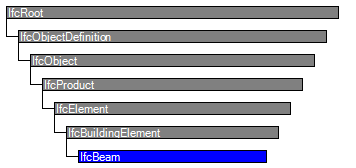
| # | Attribute | Type | Cardinality | Description | B |
|---|---|---|---|---|---|
| IfcRoot | |||||
| 1 | GlobalId | IfcGloballyUniqueId | [1:1] | Assignment of a globally unique identifier within the entire software world. | X |
| 2 | OwnerHistory | IfcOwnerHistory | [0:1] |
Assignment of the information about the current ownership of that object, including owning actor, application, local identification and information captured about the recent changes of the object,
NOTE only the last modification in stored - either as addition, deletion or modification. | X |
| 3 | Name | IfcLabel | [0:1] | Optional name for use by the participating software systems or users. For some subtypes of IfcRoot the insertion of the Name attribute may be required. This would be enforced by a where rule. | X |
| 4 | Description | IfcText | [0:1] | Optional description, provided for exchanging informative comments. | X |
| IfcObjectDefinition | |||||
| HasAssignments | IfcRelAssigns @RelatedObjects | S[0:?] | Reference to the relationship objects, that assign (by an association relationship) other subtypes of IfcObject to this object instance. Examples are the association to products, processes, controls, resources or groups. | X | |
| Nests | IfcRelNests @RelatedObjects | S[0:1] | References to the decomposition relationship being a nesting. It determines that this object definition is a part within an ordered whole/part decomposition relationship. An object occurrence or type can only be part of a single decomposition (to allow hierarchical strutures only). | ||
| IsNestedBy | IfcRelNests @RelatingObject | S[0:?] | References to the decomposition relationship being a nesting. It determines that this object definition is the whole within an ordered whole/part decomposition relationship. An object or object type can be nested by several other objects (occurrences or types). | X | |
| HasContext | IfcRelDeclares @RelatedDefinitions | S[0:1] | References to the context providing context information such as project unit or representation context. It should only be asserted for the uppermost non-spatial object. | ||
| IsDecomposedBy | IfcRelAggregates @RelatingObject | S[0:?] | References to the decomposition relationship being an aggregation. It determines that this object definition is whole within an unordered whole/part decomposition relationship. An object definitions can be aggregated by several other objects (occurrences or parts). | X | |
| Decomposes | IfcRelAggregates @RelatedObjects | S[0:1] | References to the decomposition relationship being an aggregation. It determines that this object definition is a part within an unordered whole/part decomposition relationship. An object definitions can only be part of a single decomposition (to allow hierarchical strutures only). | X | |
| HasAssociations | IfcRelAssociates @RelatedObjects | S[0:?] | Reference to the relationship objects, that associates external references or other resource definitions to the object.. Examples are the association to library, documentation or classification. | X | |
| IfcObject | |||||
| 5 | ObjectType | - | This attribute is out of scope for this model view definition and shall not be set. | ||
| IsTypedBy | IfcRelDefinesByType @RelatedObjects | S[0:1] | Set of relationships to the object type that provides the type definitions for this object occurrence. The then associated IfcTypeObject, or its subtypes, contains the specific information (or type, or style), that is common to all instances of IfcObject, or its subtypes, referring to the same type. | X | |
| IsDefinedBy | IfcRelDefinesByProperties @RelatedObjects | S[0:?] | Set of relationships to property set definitions attached to this object. Those statically or dynamically defined properties contain alphanumeric information content that further defines the object. | X | |
| IfcProduct | |||||
| 6 | ObjectPlacement | IfcObjectPlacement | [0:1] | Placement of the product in space, the placement can either be absolute (relative to the world coordinate system), relative (relative to the object placement of another product), or constraint (e.g. relative to grid axes). It is determined by the various subtypes of IfcObjectPlacement, which includes the axis placement information to determine the transformation for the object coordinate system. | X |
| 7 | Representation | IfcProductRepresentation | [0:1] | Reference to the representations of the product, being either a representation (IfcProductRepresentation) or as a special case a shape representations (IfcProductDefinitionShape). The product definition shape provides for multiple geometric representations of the shape property of the object within the same object coordinate system, defined by the object placement. | X |
| ReferencedBy | IfcRelAssignsToProduct @RelatingProduct | S[0:?] | Reference to the IfcRelAssignsToProduct relationship, by which other products, processes, controls, resources or actors (as subtypes of IfcObjectDefinition) can be related to this product. | X | |
| IfcElement | |||||
| 8 | Tag | IfcIdentifier | [0:1] | The tag (or label) identifier at the particular instance of a product, e.g. the serial number, or the position number. It is the identifier at the occurrence level. | X |
| ConnectedTo | IfcRelConnectsElements @RelatingElement | S[0:?] | Reference to the element connection relationship. The relationship then refers to the other element to which this element is connected to. | ||
| HasOpenings | IfcRelVoidsElement @RelatingBuildingElement | S[0:?] | Reference to the IfcRelVoidsElement relationship that creates an opening in an element. An element can incorporate zero-to-many openings. For each opening, that voids the element, a new relationship IfcRelVoidsElement is generated. | X | |
| ConnectedFrom | IfcRelConnectsElements @RelatedElement | S[0:?] | Reference to the element connection relationship. The relationship then refers to the other element that is connected to this element. | X | |
| ContainedInStructure | IfcRelContainedInSpatialStructure @RelatedElements | S[0:1] | Containment relationship to the spatial structure element, to which the element is primarily associated. This containment relationship has to be hierachical, i.e. an element may only be assigned directly to zero or one spatial structure. | ||
| PositionedFrom | IfcRelPositions @RelatingElement | S[0:1] | Indicates a constrained placement, where the ObjectPosition must match positioning defined according to the referenced positioning element. | X | |
| IfcBuildingElement | |||||
| IfcBeam | |||||
| 9 | PredefinedType | IfcBeamTypeEnum | [0:1] |
Predefined generic type for a beam that is specified in an enumeration. There may be a property set given specificly for the predefined types.
NOTE The PredefinedType shall only be used, if no IfcBeamType is assigned, providing its own IfcBeamType.PredefinedType. | X |
Girders are modelled as IfcBeam with IfcMaterialProfileSet indicating the material and cross-section. Steel girders are commonly represented as IfcAsymmetricIShapeProfileDef, while precast concrete girders may use custom cross-sections represented as IfcArbitraryClosedProfileDef.
Beam geometry may be generically described by applying the profile to an alignment curve using IfcFixedReferenceSweptAreaSolid. Alternatively, straight segments may use IfcExtrudedAreaSolid, and segments with tapered sections may use IfcExtrudedAreaSolidTapered. Alternatively, IfcSectionedSpine may be used to capture multiple discretized profile segments.

|
Figure 1 — Bridge girder model |
As shown in Figure 1, girders may be split into segments according to defined splices. The gaps in the illustration are exagerated to show each segment.
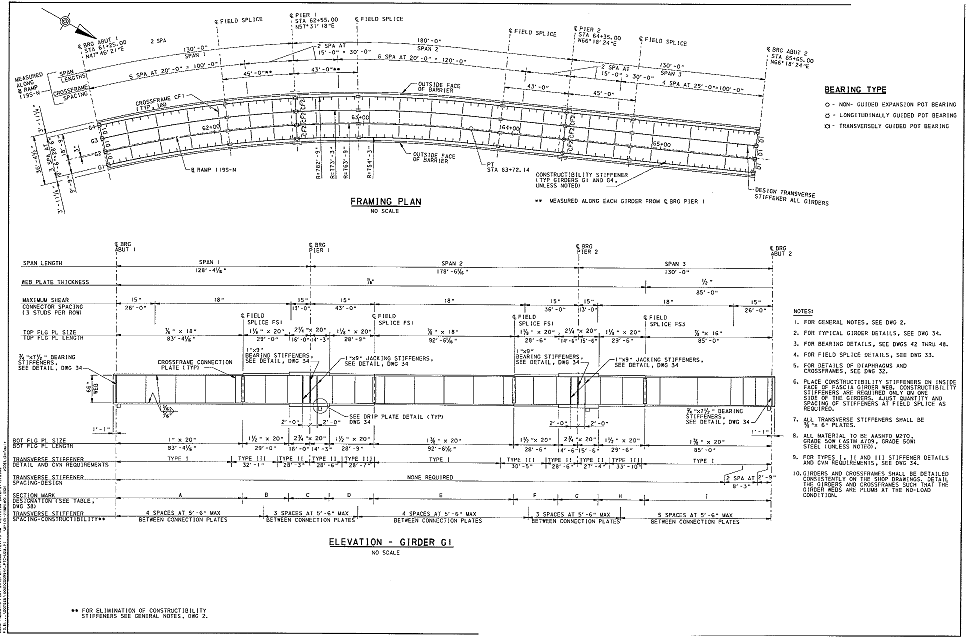
|
Figure 2 — Bridge girder plans |
The connection between beams is represented using IfcRelConnectsWithRealizingElements, where the RealizingElements refers to IfcPlate elements for fastening plates on each side, IfcFastener for bolts, and IfcPlate for any flange transition plates. The reason for using this connection relationship specifically (as opposed to just placing the elements) is to be able to derive an IfcStructuralAnalysisModel that captures the beam connectivity.
Geometry for bridge girders fits four general cases, where 'Alignment curves' indicates whether the horizontal and/or vertical alignment has any curvature (rather than straight line), 'Cross section rotates' indicates whether there is super-elevation such that the same profile may be rotated along the alignment, and 'Cross section varies' indicates that working points of the profile vary independently along the alignment, such as for keeping surfaces in contact with girders in the horizontal plane while the cross-section has an incline overall.
| Entity | Alignment curves | Cross section rotates | Cross section varies |
|---|---|---|---|
| IfcExtrudedAreaSolid | No | No | No |
| IfcFixedReferenceSweptAreaSolid | Yes | No | No |
| IfcSurfaceCurveSweptAreaSolid | Yes | Yes | No |
| IfcSectionedSpine | Yes | Yes | Yes |
Object Typing
The Object Typing concept applies to this entity as shown in Table 20.
| ||
Table 20 — IfcBeam Object Typing |
| Exchange | ||||
|---|---|---|---|---|
| Import | O | |||
| Export | O |
Quantity Sets
The Quantity Sets concept applies to this entity as shown in Table 21.
| ||
Table 21 — IfcBeam Quantity Sets |
| Exchange | ||||
|---|---|---|---|---|
| Import | O | |||
| Export | O |
Material Profile Set
The Material Profile Set concept applies to this entity.
The material of the IfcBeam is defined by the IfcMaterialProfileSet or as fallback by IfcMaterial, and it is attached either directly or at the IfcBeamType.
NOTE It is illegal to assign an IfcMaterialProfileSetUsage to an IfcBeam. Only the subtype IfcBeamStandardCase supports this concept.
| Exchange | ||||
|---|---|---|---|---|
| Import | R | |||
| Export | R |
Constraint Association
The Constraint Association concept applies to this entity.
For describing a connected series of beams along a single girder line, an IfcBeam may be used to describe the overall series and nested into component beams using IfcRelNests. As the profiles (e.g. flange width, flange thickness) and other dimensions may vary along the alignment, such parameters may be described within a table (IfcTable) applied as a constraint (IfcRelAssociatesConstraint) at the outer IfcBeam – such table usage then also provides the information in a form typically shown on plans.
As shown in Figure 2, the parameters may vary within different sections along girder spans. While the underlying geometry captures the values explicitly, the girder may be described parametrically with use of an IfcTable, shown below.
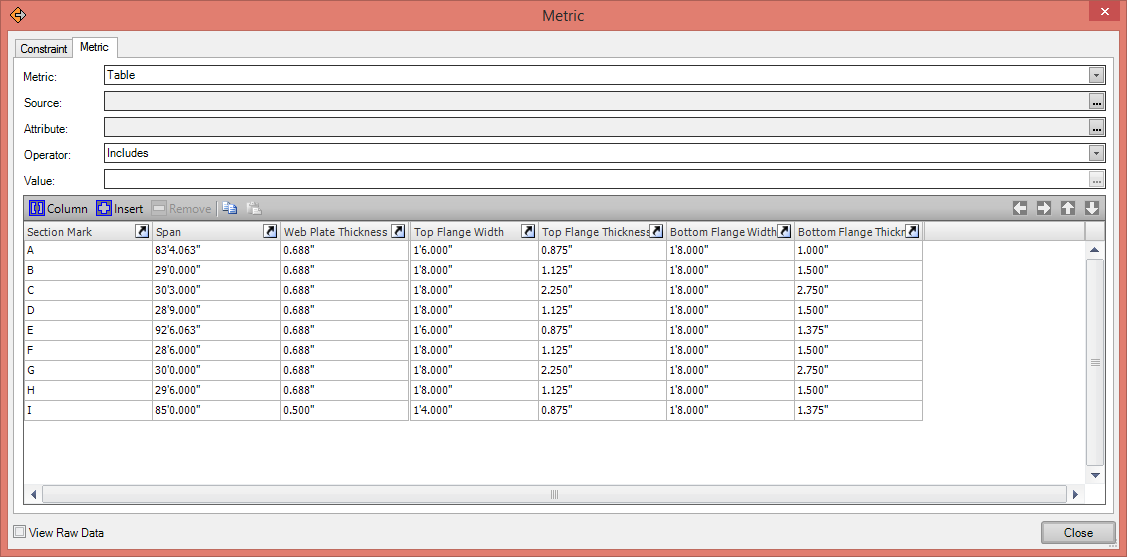
|
Figure 168 — Bridge girder table |
Within the IfcTable shown in Figure 168, each column is represented by IfcTableColumn and may have mappings described as shown below.
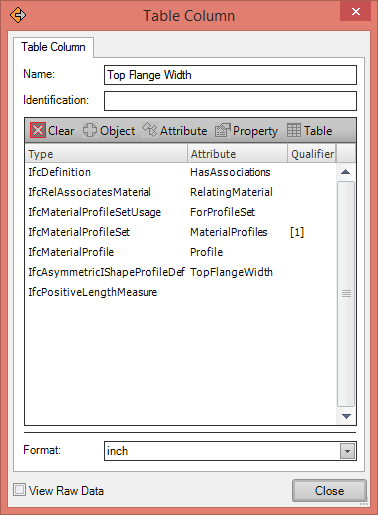
|
Figure 169 — Bridge girder parameter |
Such mappings are captured as a chain of IfcReference structures defined on IfcTableColumn.
| Exchange | ||||
|---|---|---|---|---|
| Import | O | |||
| Export | O |
Structural Curve Assignment
The Structural Curve Assignment concept applies to this entity.
Camber ordinates may be derived from structural load results related to total dead load. For geometry that resides within spatial structures, it is assumed that all dimensions reflect the conditions as constructed in place (where such camber would be balanced out by resulting loads), therefore any camber must be modelled separately. To relate camber to specific load results and load cases, the IfcBeam may link to an idealized structural model using the assignment relationship IfcRelAssignsToProduct, where RelatedObjects refers to the IfcBeam and RelatedObjects contains one or more idealized IfcStructuralCurveMember instances, where load results may be traversed following the AssignedStructuralActivity inverse attribute where IfcRelConnectsStructuralActivity.AppliedLoad refers to an IfcStructuralCurveReaction instance within a result set (HasAssignments related to IfcStructuralResultGroup via IfcRelAssignsToGroup) corresponding to the load combination (IfcStructuralLoadGroup) and analytical member (IfcStructuralCurveMember).
| Exchange | ||||
|---|---|---|---|---|
| Import | R | R | R | |
| Export | R | R | R |
Axis 3D Geometry
The Axis 3D Geometry concept applies to this entity as shown in Table 22.
| ||||||||
Table 22 — IfcBeam Axis 3D Geometry |
The 'Axis' 'Curve 3D' geometry can be used to represent the system axis and length of a beam that may extent the body length.
NOTE The 'Axis' is not used to locate the material profile set, only the subtype IfcBeamStandardCase provides this capability.
| Exchange | ||||
|---|---|---|---|---|
| Import | ||||
| Export |
Body SweptSolid Geometry
The Body SweptSolid Geometry concept applies to this entity as shown in Table 23.
| ||||||||||||||||
Table 23 — IfcBeam Body SweptSolid Geometry |
The following additional constraints apply to the 'SweptSolid' representation type:
Figure 170 illustrates the 'SweptSolid' geometric representation. There are no restrictions or conventions on how to use the local placement (black), solid of extrusion placement (red) and profile placement (green).
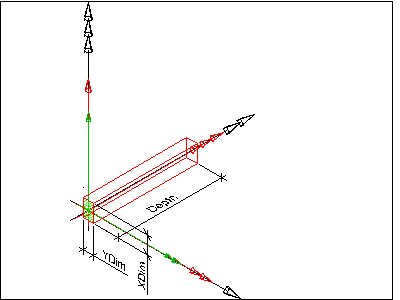 |
Figure 170 — Beam swept solid |
Figure 171 illustrates the use of non-perpendicular extrusion to create the IfcExtrudedAreaSolid.
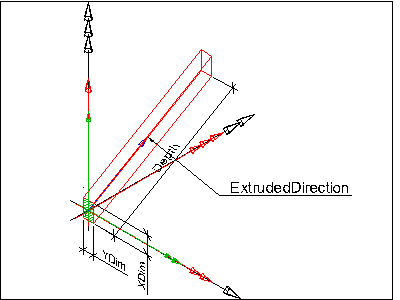 |
Figure 171 — Beam non-perpendicular extrusion |
| Exchange | ||||
|---|---|---|---|---|
| Import | O | |||
| Export | O |
Body AdvancedSweptSolid Geometry
The Body AdvancedSweptSolid Geometry concept applies to this entity.
The following additional constraints apply to the 'AdvancedSweptSolid' representation type:
NOTE View definitions and implementer agreement can further constrain the allowed swept solid types.
| Exchange | ||||
|---|---|---|---|---|
| Import | O | |||
| Export | O |
Body SweptSolid ParameterizedProfile Geometry
The Body SweptSolid ParameterizedProfile Geometry concept applies to this entity.
Figure 171 illustrates usage of IfcExtrudedAreaSolid having IfcTShapeProfileDef to represent a cap-beam of a concrete box girder bridge. Note that the direction of extrusion does not necessarily correspond with the direction of load transfer such as in this case.
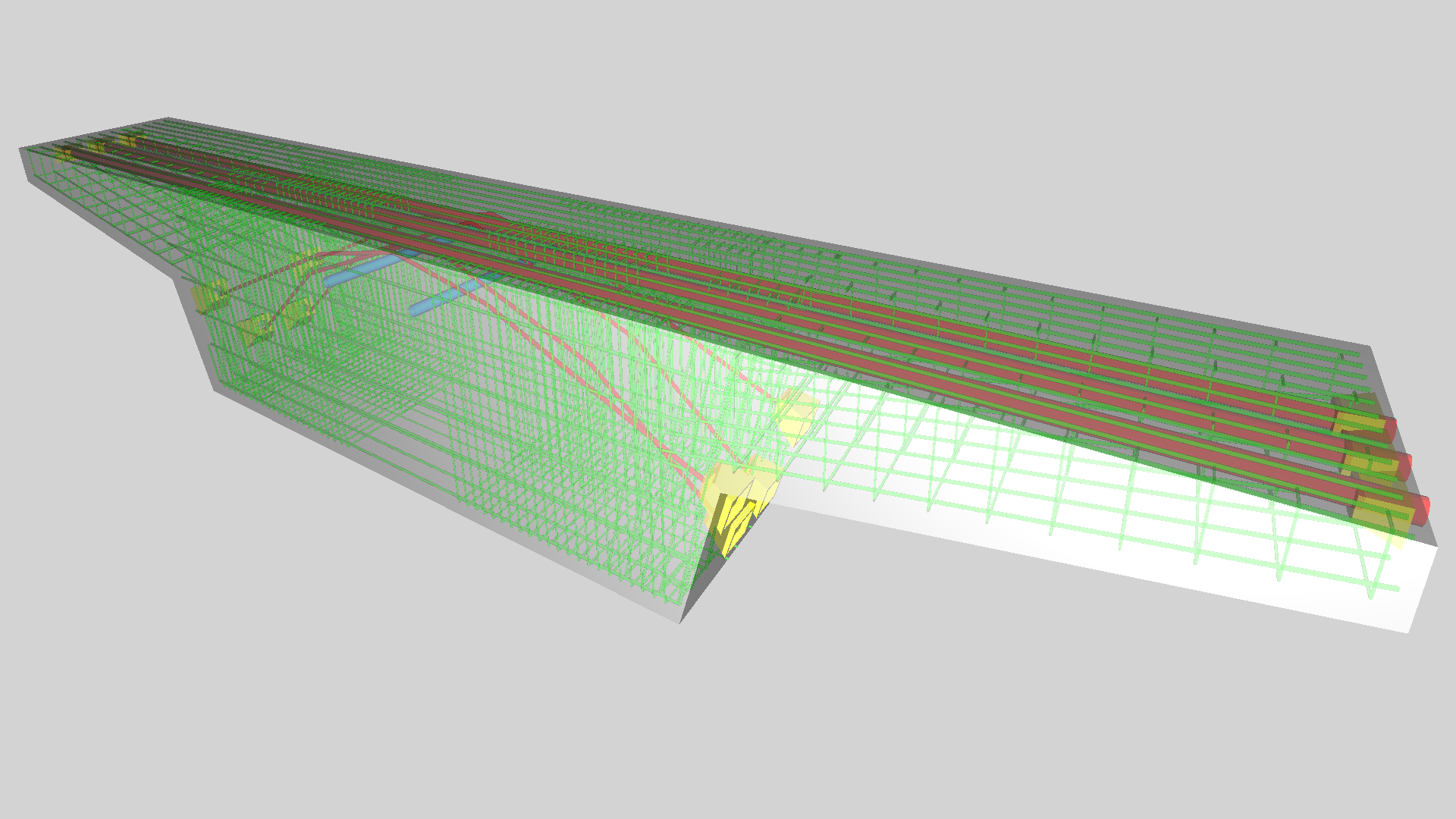
|
Figure 171 — Bridge cap beam geometry |
| Exchange | ||||
|---|---|---|---|---|
| Import | O | |||
| Export | O |
Element Decomposition
The Element Decomposition concept applies to this entity as shown in Table 24.
| ||||||||
Table 24 — IfcBeam Element Decomposition |
As shown in Figure 172, concrete box girders may contain components for rebar. Each IfcReinforcingElement corresponds to a particular bending shape and configuration (defined at the linked IfcReinforcingElementType having geometry defined by IfcSweptDiskSolidPolygonal) placed multiple times along a pattern, where each placement instance is defined using IfcMappedItem.
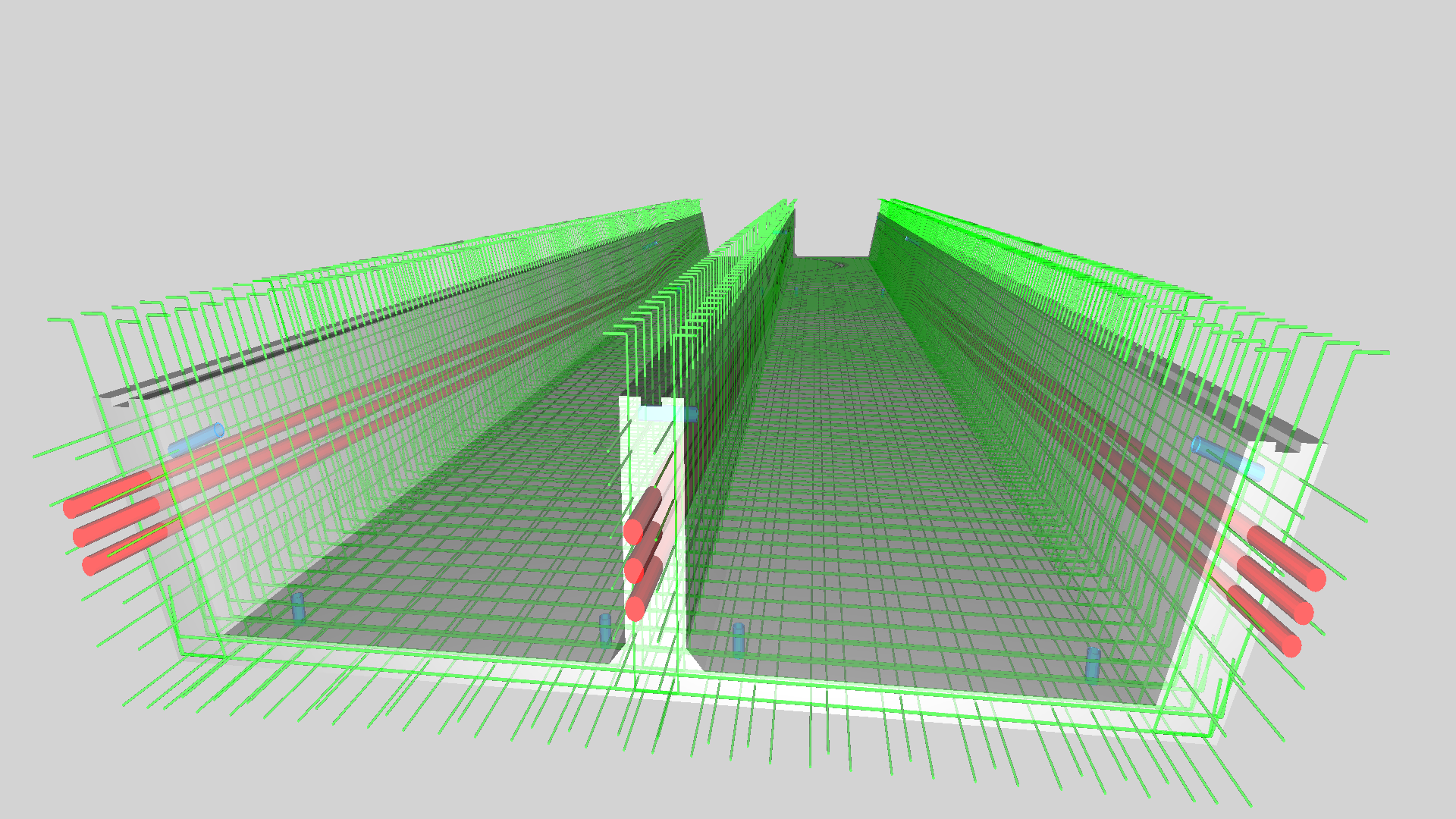
|
Figure 172 — Bridge girder components |
| Exchange | ||||
|---|---|---|---|---|
| Import | O | |||
| Export | O |
Annotation 2D Geometry
The Annotation 2D Geometry concept applies to this entity as shown in Table 25.
| ||||||||||||||||
Table 25 — IfcBeam Annotation 2D Geometry |
For fabrication, piece marks, pop marks, and contour marks may be designated using the 'Annotation' representation.
| Exchange | ||||
|---|---|---|---|---|
| Import | O | |||
| Export | O |
Path Connectivity
The Path Connectivity concept applies to this entity.
Connectivity to other elements, including adjoining girder segments on each end and stiffeners along, this relationship may be used.
Stiffeners are represented using IfcPlate, where a single instance of IfcPlate may be used for each side of the web of component beams to capture all placements, where IfcMappedItem geometry indicates the positioning for each repetition. The spacing of stiffeners may also be captured parametrically within the IfcTable at IfcBeam. The IfcPlate is connected to the component IfcBeam using IfcRelConnectsElements where RelatingElement refers to the IfcBeam.
Shear studs are represented using IfcMember, where a single instance of IfcMember may be used corresponding to each IfcBeam component, where IfcMappedItem geometry indicates the positioning for each repetition. The spacing of shear studs may also be captured parametrically within the IfcTable at IfcBeam. The IfcMember is connected to the component IfcBeam using IfcRelConnectsElements where RelatingElement refers to the IfcBeam.
| Exchange | ||||
|---|---|---|---|---|
| Import | R | |||
| Export | R |
Element Positioning
The Element Positioning concept applies to this entity as shown in Table 26.
| |||||||||
Table 26 — IfcBeam Element Positioning |
| Exchange | ||||
|---|---|---|---|---|
| Import | O | O | O | |
| Export | O | O | O |
| # | Concept | Model View |
|---|---|---|
| IfcRoot | ||
| Software Identity | Bridge View | |
| User Identity | Bridge View | |
| Object Ownership | Bridge View | |
| IfcObject | ||
| Property Sets for Objects | Bridge View | |
| IfcElement | ||
| Element Occurrence Attributes | Bridge View | |
| Product Local Placement | Bridge View | |
| Product Assignment | Bridge View | |
| IfcBeam | ||
| Object Typing | Bridge View | |
| Quantity Sets | Bridge View | |
| Material Profile Set | Bridge View | |
| Constraint Association | Bridge View | |
| Structural Curve Assignment | Bridge View | |
| Axis 3D Geometry | Bridge View | |
| Body SweptSolid Geometry | Bridge View | |
| Body AdvancedSweptSolid Geometry | Bridge View | |
| Body SweptSolid ParameterizedProfile Geometry | Bridge View | |
| Element Decomposition | Bridge View | |
| Annotation 2D Geometry | Bridge View | |
| Path Connectivity | Bridge View | |
| Element Positioning | Bridge View | |
<xs:element name="IfcBeam" type="ifc:IfcBeam" substitutionGroup="ifc:IfcBuildingElement" nillable="true"/>
<xs:complexType name="IfcBeam">
<xs:complexContent>
<xs:extension base="ifc:IfcBuildingElement">
<xs:attribute name="PredefinedType" type="ifc:IfcBeamTypeEnum" use="optional"/>
</xs:extension>
</xs:complexContent>
</xs:complexType>
ENTITY IfcBeam
SUBTYPE OF (IfcBuildingElement);
PredefinedType : OPTIONAL IfcBeamTypeEnum;
WHERE
CorrectPredefinedType : NOT(EXISTS(PredefinedType)) OR
(PredefinedType <> IfcBeamTypeEnum.USERDEFINED) OR
((PredefinedType = IfcBeamTypeEnum.USERDEFINED) AND EXISTS (SELF\IfcObject.ObjectType));
CorrectTypeAssigned : (SIZEOF(IsTypedBy) = 0) OR
('IFCSHAREDBLDGELEMENTS.IFCBEAMTYPE' IN TYPEOF(SELF\IfcObject.IsTypedBy[1].RelatingType));
END_ENTITY;